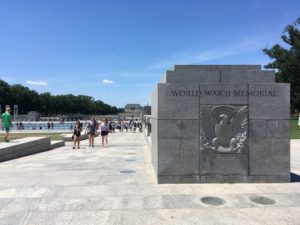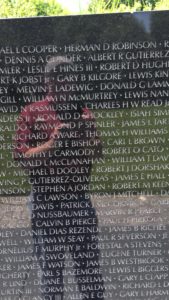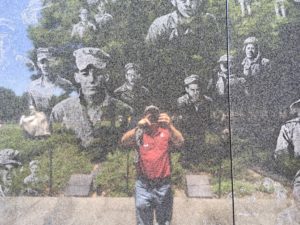
A few unexpected extra hours in Washington, D.C. recently allowed me to visit the World War II Memorial, the Korean War Veterans Memorial, and the Vietnam Veterans Memorial. The experience left me with a powerful insight into how immersive physical design can create a visceral human connection to their subject.
All three memorials are incredible displays of physical art. They evoke solemn meditations about the conflicts and the sacrifices our citizens have made over the last seventy years. The World War II Memorial, in particular, was amazing in its ability to communicate the breadth of the conflict and America’s engagement. Its design makes it impossible to capture the entire memorial in one setting, surely an intentional design feature. Visitors are overwhelmed physically with a sense of scope of the conflict.

The Korean War Memorial and Vietnam Veteran’s Memorial, however, were much more intimate. These conflicts were geographically more contained and the aesthetics allowed for a more intimate design and personal experience. Interestingly, I discovered that just as many Americans died in the Korean conflict as those who perished in the Vietnam War although fewer were wounded.

The Vietnam Memorial descends from the surface to several feet below the surface, drawing the visitor into the ground while being surrounded by the names of the fallen. The first names start at the bottom of the soles of your shoes and gradually increase in vertical length with each step toward the lowest point. At the tip of the angled pathway, the names of those killed in action extend well over the heads of visitors (10 feet at the highest point). As you look into the wall, the names of those killed appear over the reflection of the visitor. The effect is striking, making it impossible for a visitor not to be immersed in the tragic death of the men and women who served in the conflict.

The Korean War Memorial achieves the same aesthetic and emotional impact, but in a very different way. In fact, the images are even more haunting in some ways. Visitors follow a pathway around a triangular garden containing a squad of infantry marching through shin-high foliage. The Korean War Memorial also has a wall with scenes from people and the action etched into the marble. The experience, however, is much different for the visitor. Those looking at the images will see their own reflections mixed in with the faces of the men and women etched onto the wall. The effect is to visually immerse the visitor into the art.
By immersing visitors into the etched images on their walls, each visitor creates their own story, their own connection to the conflict and the individuals involved. Both memorials are extraordinary examples of how physical art is infused visually into the perceptions of the person viewing, connecting at a visceral and emotional level. This is art at its highest form. Art tells a story, but the meaning is both intimate and unique to the individual.